Interventions to reduce contaminated aerosols produced during dental procedures for preventing infectious diseases
- PMID: 33047816
- PMCID: PMC8164845
- DOI: 10.1002/14651858.CD013686.pub2
Interventions to reduce contaminated aerosols produced during dental procedures for preventing infectious diseases
Abstract
Background: Many dental procedures produce aerosols (droplets, droplet nuclei and splatter) that harbour various pathogenic micro-organisms and may pose a risk for the spread of infections between dentist and patient. The COVID-19 pandemic has led to greater concern about this risk.
Objectives: To assess the effectiveness of methods used during dental treatment procedures to minimize aerosol production and reduce or neutralize contamination in aerosols.
Search methods: Cochrane Oral Health's Information Specialist searched the following databases on 17 September 2020: Cochrane Oral Health's Trials Register, the Cochrane Central Register of Controlled Trials (CENTRAL) (in the Cochrane Library, 2020, Issue 8), MEDLINE Ovid (from 1946); Embase Ovid (from 1980); the WHO COVID-19 Global literature on coronavirus disease; the US National Institutes of Health Trials Registry (ClinicalTrials.gov); and the Cochrane COVID-19 Study Register. We placed no restrictions on the language or date of publication.
Selection criteria: We included randomized controlled trials (RCTs) and controlled clinical trials (CCTs) on aerosol-generating procedures (AGPs) performed by dental healthcare providers that evaluated methods to reduce contaminated aerosols in dental clinics (excluding preprocedural mouthrinses). The primary outcomes were incidence of infection in dental staff or patients, and reduction in volume and level of contaminated aerosols in the operative environment. The secondary outcomes were cost, accessibility and feasibility.
Data collection and analysis: Two review authors screened search results, extracted data from the included studies, assessed the risk of bias in the studies, and judged the certainty of the available evidence. We used mean differences (MDs) and 95% confidence intervals (CIs) as the effect estimate for continuous outcomes, and random-effects meta-analysis to combine data. We assessed heterogeneity.
Main results: We included 16 studies with 425 participants aged 5 to 69 years. Eight studies had high risk of bias; eight had unclear risk of bias. No studies measured infection. All studies measured bacterial contamination using the surrogate outcome of colony-forming units (CFU). Two studies measured contamination per volume of air sampled at different distances from the patient's mouth, and 14 studies sampled particles on agar plates at specific distances from the patient's mouth. The results presented below should be interpreted with caution as the evidence is very low certainty due to heterogeneity, risk of bias, small sample sizes and wide confidence intervals. Moreover, we do not know the 'minimal clinically important difference' in CFU. High-volume evacuator Use of a high-volume evacuator (HVE) may reduce bacterial contamination in aerosols less than one foot (~ 30 cm) from a patient's mouth (MD -47.41, 95% CI -92.76 to -2.06; 3 RCTs, 122 participants (two studies had split-mouth design); very high heterogeneity I² = 95%), but not at longer distances (MD -1.00, -2.56 to 0.56; 1 RCT, 80 participants). One split-mouth RCT (six participants) found that HVE may not be more effective than conventional dental suction (saliva ejector or low-volume evacuator) at 40 cm (MD CFU -2.30, 95% CI -5.32 to 0.72) or 150 cm (MD -2.20, 95% CI -14.01 to 9.61). Dental isolation combination system One RCT (50 participants) found that there may be no difference in CFU between a combination system (Isolite) and a saliva ejector (low-volume evacuator) during AGPs (MD -0.31, 95% CI -0.82 to 0.20) or after AGPs (MD -0.35, -0.99 to 0.29). However, an 'n of 1' design study showed that the combination system may reduce CFU compared with rubber dam plus HVE (MD -125.20, 95% CI -174.02 to -76.38) or HVE (MD -109.30, 95% CI -153.01 to -65.59). Rubber dam One split-mouth RCT (10 participants) receiving dental treatment, found that there may be a reduction in CFU with rubber dam at one-metre (MD -16.20, 95% CI -19.36 to -13.04) and two-metre distance (MD -11.70, 95% CI -15.82 to -7.58). One RCT of 47 dental students found use of rubber dam may make no difference in CFU at the forehead (MD 0.98, 95% CI -0.73 to 2.70) and occipital region of the operator (MD 0.77, 95% CI -0.46 to 2.00). One split-mouth RCT (21 participants) found that rubber dam plus HVE may reduce CFU more than cotton roll plus HVE on the patient's chest (MD -251.00, 95% CI -267.95 to -234.05) and dental unit light (MD -12.70, 95% CI -12.85 to -12.55). Air cleaning systems One split-mouth CCT (two participants) used a local stand-alone air cleaning system (ACS), which may reduce aerosol contamination during cavity preparation (MD -66.70 CFU, 95% CI -120.15 to -13.25 per cubic metre) or ultrasonic scaling (MD -32.40, 95% CI - 51.55 to -13.25). Another CCT (50 participants) found that laminar flow in the dental clinic combined with a HEPA filter may reduce contamination approximately 76 cm from the floor (MD -483.56 CFU, 95% CI -550.02 to -417.10 per cubic feet per minute per patient) and 20 cm to 30 cm from the patient's mouth (MD -319.14 CFU, 95% CI - 385.60 to -252.68). Disinfectants ‒ antimicrobial coolants Two RCTs evaluated use of antimicrobial coolants during ultrasonic scaling. Compared with distilled water, coolant containing chlorhexidine (CHX), cinnamon extract coolant or povidone iodine may reduce CFU: CHX (MD -124.00, 95% CI -135.78 to -112.22; 20 participants), povidone iodine (MD -656.45, 95% CI -672.74 to -640.16; 40 participants), cinnamon (MD -644.55, 95% CI -668.70 to -620.40; 40 participants). CHX coolant may reduce CFU more than povidone iodine (MD -59.30, 95% CI -64.16 to -54.44; 20 participants), but not more than cinnamon extract (MD -11.90, 95% CI -35.88 to 12.08; 40 participants).
Authors' conclusions: We found no studies that evaluated disease transmission via aerosols in a dental setting; and no evidence about viral contamination in aerosols. All of the included studies measured bacterial contamination using colony-forming units. There appeared to be some benefit from the interventions evaluated but the available evidence is very low certainty so we are unable to draw reliable conclusions. We did not find any studies on methods such as ventilation, ionization, ozonisation, UV light and fogging. Studies are needed that measure contamination in aerosols, size distribution of aerosols and infection transmission risk for respiratory diseases such as COVID-19 in dental patients and staff.
Trial registration: ClinicalTrials.gov NCT04430387.
Copyright © 2020 The Cochrane Collaboration. Published by John Wiley & Sons, Ltd.
Conflict of interest statement
SKN: none PE: none MP: none MN: none GS: none JHV: none
Figures

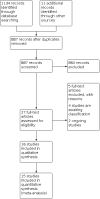

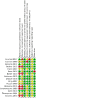
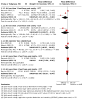
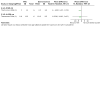
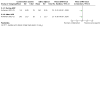
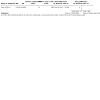
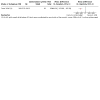
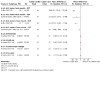
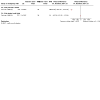
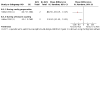
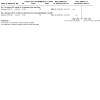
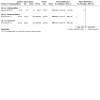

Update of
- doi: 10.1002/14651858.CD013686
References
References to studies included in this review
Al‐amad 2017 {published and unpublished data}
-
- Al-amad 2017 [pers comm]. Allocation concealment and standard deviations used in our trial. E-mail to Prashanti Eachempati 28 July 2020.
-
- Al-amad SH, Awad MA, Edher FM, Shahramian K, Omran TA. The effect of rubber dam on atmospheric bacterial aerosols during restorative dentistry. Journal of Infection and Public Health 2017;10(2):195-200. - PubMed
Cochran 1989 {published data only}
-
- Cochran MA, Miller CH, Sheldrake MA. The efficacy of the rubber dam as a barrier to the spread of microorganisms during dental treatment. Journal of American Dental Association 1989;119(1):141-4. - PubMed
Desarda 2014 {published data only}
Devker 2012 {published data only}
-
- Devker N, Mohitey J, Vibhute A, Chouhan VS, Chavan P, Malagi S, et al. A study to evaluate and compare the efficacy of preprocedural mouthrinsing and high volume evacuator attachment alone and in combination in reducing the amount of viable aerosols produced during ultrasonic scaling procedure. Journal of Contemporary Dental Practice 2012;13(5):681-9. - PubMed
El‐Din 1997 {published data only}
-
- El-Din ALT, Ghoname AE. Efficacy of rubber dam isolation as an infection control procedure in pediatric dentistry. Eastern Mediterranean Health Journal 1997;3(3):530-9.
Frere 2016 {published and unpublished data}
-
- Frere AD, Margulis KS, Yeroshalmi F, Badner V. Effectiveness of two isolation techniques in aerosol/spatter reduction. zyris.com/wp-content/uploads/2020/03/Effectiveness-of-Two-Isolation-Tech... 2016.
-
- Yeroshalmi F [pers comm]. Random sequence generation details of our trial. E-mail to Sumanth Kumbargere Nagraj 24 June 2020.
Hallier 2010 {published data only}
Holloman 2015 {published data only}
-
- Holloman JL, Mauriello SM, Pimenta L, Arnold RR. Comparison of suction device with saliva ejector for aerosol and spatter reduction during ultrasonic scaling. Journal of the American Dental Association (1939) 2015;146(1):27-33. [PMID: ] - PubMed
Jawade 2016 {published data only}
King 1997 {published data only}
-
- King TB, Muzzin KB, Berry CW, Anders LM. The effectiveness of an aerosol reduction device for ultrasonic sealers. Journal of Periodontology 1997;68:45-9. - PubMed
Muzzin 1999 {published data only}
-
- Muzzin KB, King TB, Berry CW. Assessing the clinical effectiveness of an aerosol reduction device for the air polisher. Journal of the American Dental Association 1999;130(9):1354-9. - PubMed
Narayana 2016 {published data only}
Samaranayake 1989 {published data only}
-
- Samaranayake LP, Reid J, Evans D. The efficacy of rubber dam isolation in reducing atmospheric bacterial contamination. ASDC Journal of Dentistry for Children 1989;56(6):442-4. [PMID: ] - PubMed
Sethi 2019 {published data only}
-
- Mamajiwala A [pers comm]. Allocation concealment and protocol publication details of our trial. E-mail reply to Prashanti Eachempati 27 July 2020.
Timmerman 2004 {published data only}
Williams 1970 {published data only}
-
- Williams GH, Pollok NL, Shay DE, Barr CE. Laminar air purge of microorganisms in dental aerosols: prophylactic procedures with the ultrasonic scaler. Journal of Dental Research 1970;49(6):1498-504. - PubMed
References to studies excluded from this review
Bentley 1994 {published data only}
-
- Bentley CD, Burkhart NW, Crawford JJ. Evaluating spatter and aerosol contamination during dental procedures. Journal of American Dental Association 1994;125(May):579-84. - PubMed
Larato 1967 {published data only}
-
- Larato DC, Ruskin PF, Martin A. Effect of an ultrasonic scaler on bacterial counts in air. Journal of Periodontology 1967;38(6):550-4. [PMID: ] - PubMed
Muir 1978 {published data only}
-
- Muir KF, Ross PW, MacPhee IT, Holbrook WP, Kowolik MJ. Reduction of microbial contamination from ultrasonic scalers. British Dental Journal 1978;145:76-8. - PubMed
Watanabe 2018 {published data only}
Yamada 2011 {published data only}
-
- Yamada H, Ishihama K, Yasuda K, Hasumi-Nakayama Y, Shimoji S, Furusawa K. Aerial dispersal of blood-contaminated aerosols during dental procedures. Quintessence International 2011;42(5):399-405. - PubMed
References to studies awaiting assessment
Allison 2020 {unpublished data only}
Klyn 2001 {published data only}
-
- Klyn SL, Cummings DE, Richardson BW, Davis RD. Reduction of bacteria-containing spray produced during ultrasonic scaling. General dentistry 2001;49(6):648-52. - PubMed
Llandro 2020 {unpublished data only}
Worrall 1987 {published data only}
-
- Worrall SF, Knibbs PJ, Glenwright HD. Methods of reducing bacterial contamination of the atmosphere arising from use of an air-polisher. British Dental Journal 1987;163(August):118-9. - PubMed
References to ongoing studies
ISRCTN10378358 {published data only}
-
- Oral fluorescein as a biomarker for droplet and aerosol spread of COVID-19 within a clinical environment. Ongoing study. 15 June 2020. Contact author for more information.
NCT04430387 {published data only}
-
- Evaluation of impact on environmental spatter using different isolation methods during hygiene appointment among pediatric patients. Ongoing study. 11 June 2020. Contact author for more information.
Additional references
ADA 2020
-
- American Dental Association. COVID-19 frequently asked questions. success.ada.org/en/practice-management/patients/coronavirus-frequently-a... (accessed 16 April 2020).
Al‐Eid 2018
ALOP 2020
-
- The Latin American Association of Pediatric Dentistry (Asociación Latinoamericana de Odontopediatría ALOP). Recommendations for care in pediatric dentistry versus Covid-19. www.acop.com.co/2020/04/13/recomendaciones-de-atencion-en-odontopediatri... (accessed 13 April 2020).
Avasthi 2018
-
- Avasthi A. High volume evacuator (HVE) in reducing aerosol – an exploration worth by clinicians. Journal of Dental Health, Oral Disorders & Therapy 2018;9(3):165-6.
Bali 2014
Barnes 1998
-
- Barnes JB, Harrel SK, Rivera-Hidalgo F. Blood contamination of the aerosols produced by in vivo use of ultrasonic scalers. Journal of Periodontology 1998;69(4):434-8. - PubMed
BDA 2020a
-
- British Dental Association. Personal protective equipment (PPE). bda.org/advice/Coronavirus/Pages/face-mask-shortage.aspx (accessed 6 June 2020).
BDA 2020b
-
- British Dental Association. Coronavirus: the financial impact. bda.org/advice/Coronavirus/Pages/financial-impact.aspx (accessed 6 June 2020).
Brown 1999
-
- Brown K, Xu Y. Fogging for the disinfection of food processing factories and equipment. Trends in Food Science & Technology 1999;10(6-7):205-10.
Burton 2020a
-
- Burton MJ, Clarkson JE, Goulao B, Glenny A-M, McBain AJ, Schilder AG, et al. Antimicrobial mouthwashes (gargling) and nasal sprays to protect healthcare workers when undertaking aerosol-generating procedures (AGPs) on patients without suspected or confirmed COVID-19 infection. Cochrane Database of Systematic Reviews 2020, Issue 5. Art. No: CD013628. [DOI: 10.1002/14651858.CD013628] - DOI - PMC - PubMed
Burton 2020b
-
- Burton MJ, Clarkson JE, Goulao B, Glenny A-M, McBain AJ, Schilder AG, et al. Use of antimicrobial mouthwashes (gargling) and nasal sprays by healthcare workers to protect them when treating patients with suspected or confirmed COVID-19 infection. Cochrane Database of Systematic Reviews 2020, Issue 5. Art. No: CD013626. [DOI: 10.1002/14651858.CD013626] - DOI - PMC - PubMed
CDC 2020
-
- Centers for Disease Control and Prevention. Dental settings: interim infection prevention and control guidance for dental settings during the COVID-19 response. www.cdc.gov/coronavirus/2019-ncov/hcp/dental-settings.html (accessed 27 April 2020).
Chou 2020
Clarkson 2020
-
- Clarkson J, Ramsay C, Richards D, Robertson C, & Aceves-Martins M, on behalf of the CoDER Working Group. Aerosol Generating Procedures and their Mitigation in International Dental Guidance Documents - A Rapid Review. oralhealth.cochrane.org/sites/oralhealth.cochrane.org/files/public/uploa.... 2020.
COMET 2020
-
- COMET. Core Outcome Measures in Effectiveness Trials. www.comet-initiative.org (accessed 19 May 2020).
CONSORT 2010
-
- CONSORT Group. CONSORT Statement. www.consort- statement.org/ (accessed 15 September 2019) 2010.
Cottone 1991
-
- Cottone JA, Terezhalmy GT, Molinari JA. Practical Infection Control in Dentistry. Baltimore (MD): Williams and Wilkins, 1991.
Coulthard 2020
-
- Coulthard P. Dentistry and coronavirus (COVID-19) – moral decision-making. British Dental Journal 2020;228(7):503-5. - PubMed
Dahlke 2012
Dominiak 2020
-
- Dominiak M, Różyło-Kalinowska I, Gedrange T, Konopka T, Hadzik J, Bednarz W, et al. COVID-19 and professional dental practice. The Polish Dental Association Working Group recommendations for procedures in dental office during an increased epidemiological risk. Journal of Stomatology 2020;73(1):1-10.
Eggers 2018
Escombe 2019
European Standard 2009
-
- European Standard. High efficiency air filters (EPA, HEPA and ULPA). European Standard EN 1822-1:2009.
FGDP 2020
-
- Faculty of General Dental Practice (UK). COVID-19: updated guidance and resources as lockdown eases. fgdp.org.uk/news/covid-19-updated-guidance-and-resources-lockdown-eases 21 May 2020.
Fors 1986
-
- Fors UG, Berg JO, Sandberg H. Microbiological investigation of saliva leakage between the rubber dam and tooth during endodontic treatment. Journal of Endodontics 1986;12(9):396-9. [PMID: ] - PubMed
Fox 2010
-
- Fox C. Evidence summary: what 'cost of illness' evidence is there about cross-infection related infections in dental practice? British dental journal 2010;209(2):87-8. [PMID: ] - PubMed
Froum 2020
-
- Froum S, Strange M. COVID-19 and the problem with dental aerosols. www.perioimplantadvisory.com/periodontics/oral-medicine-anesthetics-and-... (accessed 6 June 2020).
GDC 2020
-
- GDC. Aerosol generating procedures. gdc-uk.org/docs/default-source/covid-19/use-of-aerosol-generating-proced... 18 March 2020.
Ghosh 2015
GRADEpro GDT [Computer program]
-
- GRADEpro GDT. Version accessed 1 July 2020. Hamilton (ON): McMaster University (developed by Evidence Prime). Available at gradepro.org.
Graetz 2014
-
- Graetz C, Bielfeldt J, Tillner A, Plaumann A, Dörfer CE. Spatter contamination in dental practices – how can it be prevented? Revista Medico-Chirurgicala a Societatii de Medici si Naturalisti din Lasi 2014;118:1122-34. [PMID: ] - PubMed
Grinshpun 2001
-
- Grinshpun S, Mainelis G, Reponen T, Willeke K, Trunov MA, Adhikari A. Effect of wearable ionizers on the concentration of respirable airborne particles and microorganisms. Journal of Aerosol Science 2001;32(Suppl 1):S335-6.
Gross 1992
-
- Gross KB, Overman PR, Cobb C, Brockmann S. Aerosol generation by two ultrasonic scalers and one sonic scaler. A comparative study. Journal of Dental Hygiene 1992;66(7):314-8. - PubMed
Gurley 1985
-
- Gurley B. Ozone: a pharmaceutical sterilant of the future? Journal of Parenteral Science and Technology 1985;39(6):256-61. - PubMed
Górny 2020
-
- Górny RL. Microbial aerosols: sources, properties, health effects, exposure assessment – a review. KONA Powder and Particle Journal 2020;37:64-84. [DOI: 10.14356/kona.2020005] - DOI
Harrel 1996
-
- Harrel SK. Clinical use of an aerosol-reduction device with an ultrasonic scaler. Compendium of Continuing Education in Dentistry 1996;17(12):1185-93. - PubMed
Harrel 2004
Higgins 2011
-
- Higgins JP, Green S. Cochrane Handbook for Systematic Reviews of Interventions. Version 5.1.0 (updated March 2011) edition. The Cochrane Collaboration, 2011. [www.handbook.cochrane.org]
Higgins 2019
-
- Higgins JP, Thomas J, Chandler J, Cumpston M, Li T, Page MJ, et al. Cochrane Handbook for Systematic Reviews of Interventions. 2nd edition. Hoboken (NJ): Wiley-Blackwell, 2019.
Ishihama 2008
-
- Ishihama K, Iida S, Koizumi H, Wada T, Adachi T, Isomura-Tanaka E, et al. High incidence of blood exposure due to imperceptible contaminated splatters during oral surgery. Journal of Oral and Maxillofacial Surgery 2008;66(4):704-10. [PMID: ] - PubMed
Jacks 2002
-
- Jacks ME. A laboratory comparison of evacuation devices on aerosol reduction. Journal of Dental Hygiene 2002;76:202-6. - PubMed
Jain 2020
James 2016
-
- James R, Mani A. Dental aerosols: a silent hazard in dentistry! International Journal of Scientific Research 2016;5:1761-3.
Judson 2019
Koletsi 2020
-
- Koletsi D, Belibasakis GN, Eliades T. Interventions to reduce aerosolized microbes in dental practice: a systematic review with network meta-analysis of randomized controlled trials. Available at journals.sagepub.com/doi/full/10.1177/0022034520943574. [DOI: 10.1177/0022034520943574] - DOI - PubMed
Kormuth 2018
Laheij 2012
Lefebvre 2019
-
- Lefebvre C, Glanville J, Briscoe S, Littlewood A, Marshall C, Metzendorf M-I, et al. Technical supplement to Chapter 4: Searching for and selecting studies. In: Higgins JP, Thomas J, Chandler J, Cumpston MS, Li T, Page MJ, et al, editor(s). Cochrane Handbook for Systematic Reviews of Interventions, Version 6 (updated July 2019). Cochrane, 2019. Available from: www.training.cochrane.org/handbook.
Lessler 2009
Leung 2020
Lewis 2020
-
- Lewis D. Is the coronavirus airborne? Experts can't agree. Nature 2020;580(7802):175. [PMID: ] - PubMed
Lu 2020
-
- Lu M. The front line: visualizing the occupations with the highest COVID-19 risk. Visual Capitalist 15 April 2020. [www.visualcapitalist.com/the-front-line-visualizing-the-occupations-with...
Mair 2020
-
- Mair AD, Korne PH. Decoding Dental Aerosols. https://secibonline.com/wp-content/uploads/2020/05/Decoding-Dental-Aeros... [Accessed on 31 July 2020].
Mantovani 2020
-
- Mantovani C. Over 90,000 health workers infected with COVID-19 worldwide: nurses group. www.reuters.com/article/us-health-coronavirus-nurses/over-90000-health-w... 6 May 2020.
McDonnell 2006
-
- McDonnell G. Hydrogen peroxide fogging/fumigation. Journal of Hospital Infection 2006;62(3):385-6. [PMID: ] - PubMed
Meng 2020
Merriam‐Webster 2020
-
- Merriam-Webster Online Medical Dictionary. Saliva ejector. www.merriam-webster.com/medical/saliva%20ejector (accessed 5 May 2020).
Monarca 2000
NCUDSPH 2020
-
- Le Collège National des Chirurgiens-Dentistes Universitaires en Santé Publique. Recommendations to deal with the Covid19 epidemic. www.dentairesantepublique.fr/recommandations-face-a-lepidemie-covid19/ (accessed 18 March 2020).
OSHA 2020
-
- US Department of Labor: Occupational Safety and Health Administration. Guidance on preparing workplaces for COVID-19. www.osha.gov/Publications/OSHA3990.pdf (accessed prior to 16 June 2020).
Pasquarella 2000
-
- Pasquarella C, Pitzurra O, Savino A. The index of microbial air contamination. Journal of Hospital Infection 2000;46(4):241-56. - PubMed
Peng 2020
PlotDigitizer 2015 [Computer program]
-
- PlotDigitizer software. SourceForge, 3 June 2001 [revised 24 October 2015]. Available at sourceforge.net/projects/plotdigitizer.
Polednik 2014
-
- Polednik B. Aerosol and bioaerosol particles in a dental office. Environmental Research 2014;134:405-9. - PubMed
Porter 1991
-
- Porter SR. Infection control in dentistry. Current opinion in dentistry 1991;1(4):429-35. [PMID: ] - PubMed
Qian 2010
-
- Qian H, Li Y, Sun H, Nielsen PV, Huang X, Zheng X. Particle removal efficiency of the portable HEPA air cleaner in a simulated hospital ward. Building Simulation 2010;3(3):215-24.
Rautemaa 2006
Rayyan 2016 [Computer program]
-
- Rayyan QCRI, the Systematic Reviews web app. Doha, Qatar: Qatar Computing Research Institute, Hamad Bin Khalifa University, 2016.
Review Manager 2014 [Computer program]
-
- Review Manager 5 (RevMan 5). Version 5.3. Copenhagen: Nordic Cochrane Centre, The Cochrane Collaboration, 2014.
Samaranayake 2004
Sato 1990
-
- Sato H, Wananabe Y, Miyata H. Virucidal effect of ozone treatment of laboratory animal viruses. Jikken Dobutsu. Experimental Animals 1990;39(2):223-9. [PMID: ] - PubMed
Sawhney 2015
Scannapieco 1999
-
- Scannapieco F. Role of oral bacteria in respiratory infection. Journal of Periodontology 1999;70:793-801. - PubMed
Scannapieco 2004
-
- Scannapieco FA, Ho AW, DiTolla M, Chen C, Dentino AR. Exposure to the dental environment and prevalence of respiratory illness in dental student populations. Journal (Canadian Dental Association) 2004;70(3):170-4. [PMID: ] - PubMed
Sotiriou 2008
Sterne 2016
Stockwell 2019
-
- Stockwell RE, Ballard EL, O'Rourke P, Knibbs LD, Morawska L, Bell SC. Indoor hospital air and the impact of ventilation on bioaerosols: a systematic review. Journal of Hospital Infection 2019;103(2):175-84. - PubMed
Szymańska 2007
-
- Szymańska J. Dental bioaerosol as an occupational hazard in a dentist's workplace. Annals of Agricultural and Environmental Medicine : AAEM 2007;14(2):203-7. [PMID: ] - PubMed
Veeck 2004
-
- Veeck AC. Types of HEPA filters. In: NAFA Guide to Air Filtration. 3 edition. Middleton (WI): NAFA, 2004.
Veena 2015
-
- Veena HR, Mahantesha S, Joseph Preethi A, Patil Sudhir R, Patil Suvarna H. Dissemination of aerosol and splatter during ultrasonic scaling: a pilot study. Journal of Infection and Public Health 2015;8(3):260-5. - PubMed
Verbeek 2020
-
- Verbeek JH, Rajamaki B, Ijaz S, Sauni R, Toomey E, Blackwood B, et al. Personal protective equipment for preventing highly infectious diseases due to exposure to contaminated body fluids in healthcare staff. Cochrane Database of Systematic Reviews 2020, Issue 4. Art. No: CD011621. [DOI: 10.1002/14651858.CD011621.pub4] - DOI - PMC - PubMed
Warnakulasuriya 2020
WHO 2020a
-
- World Health Organization. WHO timeline – COVID-19. www.who.int/news-room/detail/27-04-2020-who-timeline---covid-19 (accessed prior to 16 June 2020).
WHO 2020b
-
- World Health Organization. Maintaining essential health services: operational guidance for the COVID-19 context - Interim guide. WHO/2019-nCoV/essential_health_services/2020.2.1 June 2020:34 and 36.
WHO 2020c
-
- World Health Organization. Transmission of SARS-CoV-2: implications for infection prevention precautions. https://www.who.int/news-room/commentaries/detail/transmission-of-sars-c... 9 July 2020.
WHO 2020d
-
- World Health Organization. Considerations for the provision of essential oral health services in the context of COVID-19 - Interim guidance. https://apps.who.int/iris/handle/10665/333625 3 August 2020.
Yadav 2015
-
- Yadav N, Agrawal B, Maheshwari C. Role of high-efficiency particulate arrestor filters in control of air borne infections in dental clinics. SRM Journal of Research in Dental Sciences 2015;6(4):240-2.
Zemouri 2017
Zyris 2020
-
- Zyris: dental isolation systems and mouthpieces (formerly Isolite). www.zyris.com/ 2020.
References to other published versions of this review
Kumbargere Nagraj 2020
-
- Kumbargere Nagraj S, Eachempati P, Paisi M, Nasser M, Sivaramakrishnan G, Verbeek JH. Interventions to reduce contaminated aerosols produced during dental procedures for preventing infectious diseases. Cochrane Database of Systematic Reviews 2020, Issue 7. Art. No: CD013686. [DOI: 10.1002/14651858.CD013686] - DOI - PMC - PubMed
Publication types
MeSH terms
Substances
Associated data
LinkOut - more resources
Full Text Sources
Medical
Research Materials
Miscellaneous

